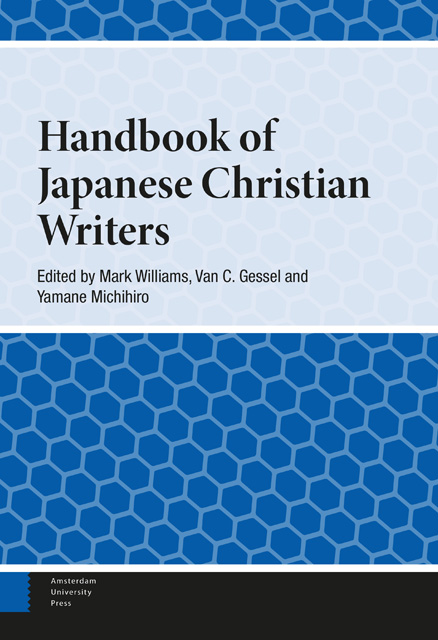Book contents
- Frontmatter
- Contents
- Contributors
- Abbreviations
- Preface
- Introduction
- 1 Prophet of the Inner Life: Kitamura Tōkoku
- 2 Shimazaki Tōson and Christianity: When the Cherries Ripen in the Taishō Period
- 3 Arishima Takeo and Christianity
- 4 Akutagawa Ryūnosuke: A Christian Life
- 5 Incarnation of the Christian Faith in the Poetry of Yagi Jūkichi
- 6 Hori Tatsuo: The Cross Dyed in Bloody Red and the Little Gods of Ancient Times
- 7 Nagai Takashi on Divine Providence and Christian Self-Surrender: Towards a New Understanding of hansai
- 8 Dazai Osamu: His Wrestle with the Bible
- 9 Shiina Rinzō: His Two Visages
- 10 From out of the Depths: Shimao Toshio’s Literary Response to Adversity
- 11 Yasuoka Shōtarō and Christianity: From Postwar “Emptiness” to Religious Longing
- 12 Miura Ayako and the Human Face of Faith
- 13 Endō Shūsaku and the Compassionate Companionship of Christ
- 14 Ogawa Kunio: Renewal of Faith and Identity in His seishomono (Bible Stories)
- 15 Kaga Otohiko: In Search of What Lies Beyond Death
- 16 Sono Ayako: Amor Vincit Omnia
- 17 Takahashi Takako: Drawing Closer to God Through Literature
- Index
- Index of titles
7 - Nagai Takashi on Divine Providence and Christian Self-Surrender: Towards a New Understanding of hansai
Published online by Cambridge University Press: 09 June 2023
- Frontmatter
- Contents
- Contributors
- Abbreviations
- Preface
- Introduction
- 1 Prophet of the Inner Life: Kitamura Tōkoku
- 2 Shimazaki Tōson and Christianity: When the Cherries Ripen in the Taishō Period
- 3 Arishima Takeo and Christianity
- 4 Akutagawa Ryūnosuke: A Christian Life
- 5 Incarnation of the Christian Faith in the Poetry of Yagi Jūkichi
- 6 Hori Tatsuo: The Cross Dyed in Bloody Red and the Little Gods of Ancient Times
- 7 Nagai Takashi on Divine Providence and Christian Self-Surrender: Towards a New Understanding of hansai
- 8 Dazai Osamu: His Wrestle with the Bible
- 9 Shiina Rinzō: His Two Visages
- 10 From out of the Depths: Shimao Toshio’s Literary Response to Adversity
- 11 Yasuoka Shōtarō and Christianity: From Postwar “Emptiness” to Religious Longing
- 12 Miura Ayako and the Human Face of Faith
- 13 Endō Shūsaku and the Compassionate Companionship of Christ
- 14 Ogawa Kunio: Renewal of Faith and Identity in His seishomono (Bible Stories)
- 15 Kaga Otohiko: In Search of What Lies Beyond Death
- 16 Sono Ayako: Amor Vincit Omnia
- 17 Takahashi Takako: Drawing Closer to God Through Literature
- Index
- Index of titles
Summary
Nagai Takashi used the biblical concept of hansai (a burnt sacrifice) in describing the atomic bombing of the Catholic Urakami district of Nagasaki and regarded the bombing as an event guided by setsuri (divine providence). His use of hansai is a pastoral device for the Catholics of Urakami, aimed at encouraging one's surrender to divine providence. Situating his conception of hansai in a theologically orthodox conception of divine providence demonstrates the ways in which Nagai seeks in his poetry and artworks to convey for Urakami Catholics a similetic or symbolic resemblance between a burnt offering and the atomic bombing of Urakami.
Introduction
This chapter explores the encounter with Catholic Christianity and issues of Christian discipleship in the life and work of the Catholic convert, radiologist and atomic bomb survivor Nagai Takashi (1908–1951). Among western scholars, Nagai is best known for his reference, in his book Nagasaki no kane (The Bells of Nagasaki,* 1949), to the biblical concept of hansai, or a “burnt sacrifice,” in describing the atomic bombing of the largely Catholic Urakami district of Nagasaki and for regarding the bombing as one manifestation of the ineluctable operations of setsuri, or divine providence. Nagai's use of the concept of hansai in conjunction with setsuri has in fact been taken by the vast majority of scholars to constitute a theologically heterodox explanation or theodicy of the atomic bombing of Urakami.
Here I aim to challenge this conventional interpretation of Nagai's use of the concepts of hansai and setsuri and to lay the foundations for what will be argued is a theologically consistent and orthodox interpretation of Nagai's use of hansai as a unique pastoral device for assisting the Catholics of Urakami—the center of Christianity in Japan at the time of the atomic bombing—to gain some semblance of peace and comfort through self-surrender to divine providence. Essential in this task is laying out the historical, biographical and theological contexts in which Nagai developed his conception of setsuri and deployed the concept of hansai.
“Hansai-setsu” and atonement
As already noted, Nagai's best-known reference to hansai features in the final chapter of his first book, The Bells of Nagasaki. Here we find an edited form of the funeral address Nagai gave, in November 1945, for the victims of the bomb in front of the ruined Urakami Cathedral.
- Type
- Chapter
- Information
- Handbook of Japanese Christian Writers , pp. 115 - 136Publisher: Amsterdam University PressPrint publication year: 2022



